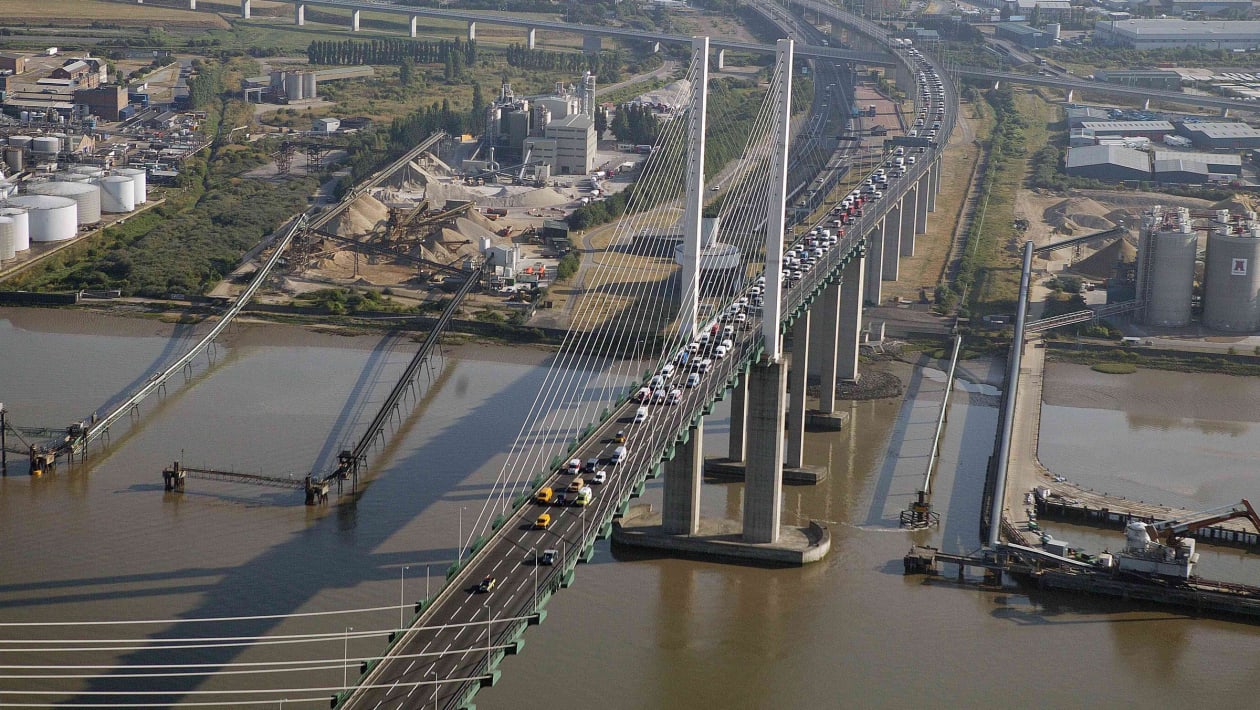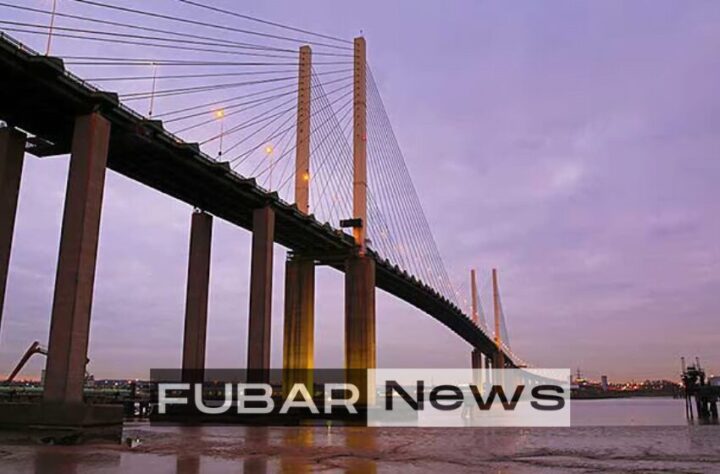The Dartford Crossing is a vital transportation link spanning the River Thames in southeast England. As one of the busiest crossings in the country, it serves as a crucial gateway for commuters, commercial traffic, and travelers alike. With a rich history, ongoing development projects, and environmental concerns, the Dartford Crossing holds much significance in the region. Let’s explore this iconic crossing in more detail.
Introduction
The Dartford Crossing, also known as the Dartford Tunnel, is a major transportation route connecting Dartford and Thurrock in the county of Essex. Situated to the east of London, it offers a crucial link for those traveling between the M25 motorway and the A2 road. The crossing comprises two tunnels and a bridge, accommodating traffic in both directions.
History of the Dartford Crossing
The history of the Dartford Crossing dates back to the mid-20th century. The original Dartford Tunnel, opened in 1963, was a single-bore tunnel designed to alleviate congestion on the A2. However, with increasing traffic demands, a second tunnel and the Queen Elizabeth II Bridge were constructed in the 1980s to accommodate the growing flow of vehicles.
Importance of the Dartford Crossing

The Dartford Crossing plays a vital role in the regional and national transportation network. It facilitates the movement of people, goods, and services, enabling economic growth and development. Thousands of commuters rely on the crossing daily, while businesses depend on it for the efficient transport of goods and supplies.
Crossing Options and Charges
Dart Charge System
To ensure smooth traffic flow and improve congestion management, the Dartford Crossing operates using a cashless payment system called Dart Charge. The system eliminates the need for toll booths, reducing delays and queues. Drivers are required to pay the crossing fee online, by phone, or via an automated payment method.
Payment Methods
The Dart Charge system provides multiple payment options to cater to the varying needs of drivers. These include online payments through the official Dart Charge website, phone payments, and payments at specific retail outlets. Additionally, there are options for registered accounts and prepaid payment options for frequent users.
Traffic Congestion and Improvement Plans
Challenges with Traffic Congestion
With its strategic location and high volume of traffic, the Dartford Crossing often faces challenges related to congestion. Heavy traffic can lead to delays and reduced travel speeds, affecting commuters and businesses. Addressing these challenges requires careful planning and ongoing improvement measures.
Current Improvement Projects
To alleviate traffic congestion, several improvement projects are underway or have been completed. These include enhancements to road infrastructure, intelligent traffic management systems, and the introduction of advanced technologies for real-time traffic monitoring and incident response.
Environmental Impact and Sustainability Measures

Air Pollution and Emissions
As a major transport route, the Dartford Crossing contributes to air pollution and emissions in the surrounding areas. Vehicle exhaust emissions are a concern, impacting local air quality and the environment. Efforts are being made to monitor and mitigate these effects through emissions reduction initiatives.
Green Initiatives
To promote sustainability, various green initiatives have been implemented. These include the installation of electric vehicle charging points, the encouragement of carpooling and public transportation, and the adoption of renewable energy sources for tunnel and bridge operations.
Safety Measures and Emergency Procedures

Safety Features
Safety is a top priority at the Dartford Crossing. The tunnels and bridge are equipped with state-of-the-art safety features, including fire detection systems, emergency telephones, and closed-circuit television (CCTV) cameras for continuous monitoring. Regular maintenance and inspections ensure the crossing’s safe operation.
Emergency Response
In the event of accidents or emergencies, a dedicated response team is on standby to handle incidents promptly. Coordinated efforts between emergency services and tunnel staff ensure the safety of all users. Regular drills and training exercises further enhance emergency preparedness.
Future Developments and Expansion
Planned Developments
Several planned developments aim to improve the Dartford Crossing’s capacity and efficiency. These include the implementation of advanced traffic management systems, additional road infrastructure, and improved access routes to enhance traffic flow.
Potential Expansion
With future demand projected to increase, discussions about potential expansion options for the Dartford Crossing have taken place. These include proposals for additional tunnels or bridges to accommodate growing traffic volumes and provide alternative routes.
Economic Impact and Benefits
Local Economy
The Dartford Crossing contributes significantly to the local economy through job creation, business opportunities, and increased regional connectivity. The crossing’s presence has stimulated economic growth in the surrounding areas, attracting investment and supporting local communities.
Employment Opportunities
The operation and maintenance of the Dartford Crossing provide employment opportunities for a diverse range of professionals. From engineering and maintenance personnel to toll collection staff and emergency response teams, the crossing plays a vital role in sustaining local employment.
Travel Tips and Recommendations

Best Times to Cross
To minimize congestion and avoid peak traffic periods, it is advisable to plan crossings during off-peak hours. Early mornings, late evenings, and weekends generally experience lighter traffic volumes. Utilizing real-time traffic information services can also help determine the best times for travel.
Alternative Routes
For those seeking alternative routes, several options exist, depending on the destination and personal preferences. These include using other river crossings, such as the Blackwall Tunnel or the Woolwich Ferry, or exploring alternative road networks to bypass the Dartford Crossing altogether.
Interesting Facts and Trivia
- The Dartford Crossing spans a total length of approximately 2.8 miles (4.5 kilometers).
- Over 150,000 vehicles cross the Dartford Crossing on an average day.
- The Queen Elizabeth II Bridge, a cable-stayed bridge, is an iconic landmark in the area.
- The Dartford Crossing was featured in various films and television shows, gaining recognition beyond its transportation significance.
Conclusion
The Dartford Crossing is a vital link connecting the banks of the Thames and facilitating efficient travel for commuters, commercial traffic, and travelers. With its rich history, ongoing development projects, and environmental concerns, the crossing continues to evolve and adapt to meet the demands of a modern transportation network.
As plans for future developments and expansion unfold, the Dartford Crossing will play an increasingly important role in sustaining regional connectivity, supporting the local economy, and improving the overall travel experience for its users.
Frequently Asked Questions (FAQs)
1. How much does it cost to cross the Dartford Crossing?
The cost of crossing the Dartford Crossing varies depending on the type of vehicle and the payment method used. It is recommended to check the official Dart Charge website for the most up-to-date pricing information.
2. What happens if I don’t pay the Dart Charge?
Failure to pay the Dart Charge can result in penalty fees and potential legal consequences. It is important to ensure that the crossing fee is paid promptly to avoid any issues.
3. Can I use the Dartford Crossing with a foreign vehicle?
Yes, foreign vehicles can use the Dartford Crossing. However, it is essential to familiarize yourself with the payment options and requirements for non-UK registered vehicles.
4. Are there any height or weight restrictions for vehicles crossing the Dartford Crossing?
There are height and weight restrictions in place for certain vehicles crossing the Dartford Crossing. It is advisable to check the official guidelines and restrictions to ensure compliance before traveling.
5. Can pedestrians or cyclists use the Dartford Crossing?
No, pedestrians and cyclists are not permitted to use the Dartford Crossing for safety reasons. Alternative routes and modes of transportation should be considered for non-vehicle users.
Also read:


